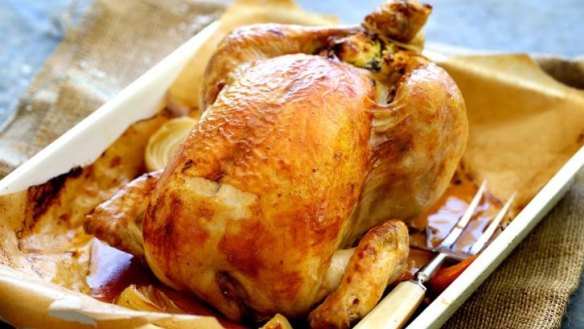What's the one recipe I should teach my child?

My eldest has finished uni and is about to leave home, and her cooking skills are nil, much to my shame. If there is one recipe I should teach my daughter, what should it be? F. Jaine
You should be ashamed. It doesn't matter what sort of level education children have attained, if they can't cook then they can't feed themselves properly. If you leave your child to the mercy of the industrial food machine she'll end up another Heart Foundation or Diabetes Australia statistic. You can make up for your remiss parenting by sending her away with a copy of The Cook's Companion by Stephanie Alexander. We posed your query to the grand dame herself. "I think probably the most useful would be how to roast a chicken with all the vegetables chopped around it so that a complete meal results if they also add something green," she replied. "If they were vegetarian I might say cauliflower cheese, as the basics of a good white sauce seemed valuable to my own kids and one can always turn the cauliflower into macaroni cheese or something else or even move on to moussaka." My food-loving colleagues on social media suggested teaching your daughter to make chicken stock. Take one kilogram of chicken carcasses and wings and simmer them in a pot of water for four hours with sliced onion, celery, carrot and perhaps some mushrooms, bay leaf, peppercorns and parsley stalks, if you have them. Strain, chill, skim and reduce. To this stock can be added chopped veg to make a nourishing soup. It can be added to rice to make risotto, and if you keep cooking risotto, you get congee.
I have a surplus of astringent persimmons. What do I do with them? N. Rosso
There are two types of persimmons. The old-fashioned American persimmons which, until they are fully soft and ripe, are so astringent they can make your mouth pucker as if you had just kissed a witch. Then there are Japanese persimmon varieties that are firm when sweet and ripe. The American variety was popular with the Atlantic coast Native Americans, who dried the fruit. It was also fermented to make persimmon wine. The skin and seeds can be removed and the remaining flesh cooked with equal amounts of sugar to make a thick, paste-like preserve. Fold the cooked flesh through cakes and steamed puddings to create a rich vein of fruit in your baking.
I toasted some nuts in the oven to 150C for 15 minutes. I returned some of the unused nuts to a jar, only to find white larvae in the jar several months later. L. Niu
Those, my friend, are Indian mealmoth larvae. They are the Benedict Cumberbatch of the pantry – they are in everything. To kill eggs and larvae (of the mealmoth, not the popular Sherlock Holmes actor) the University of Colorado recommends heating foods suspected of infestation to 140C for 20 minutes. Freezing also kills larvae. To get rid of Indian mealmoth, throw out infested food, wipe out the cupboard and store food in clean, airtight jars. Some people scatter bay leaves around the pantry. Others buy pheromone traps.
Letters
On fig sap, M. Finley writes that she applies the milky substance that oozes from the leaves to her warts to get rid of them. We also had some delightful reminiscences from readers telling us about their Italian grandmothers making fresh cheese using fig sap to set the curds. Thank you for those fond nonna memories.
Send your vexing culinary conundrums to brainfood@richardcornish.com.au or tweet to @FoodCornish
The best recipes from Australia's leading chefs straight to your inbox.
Sign up